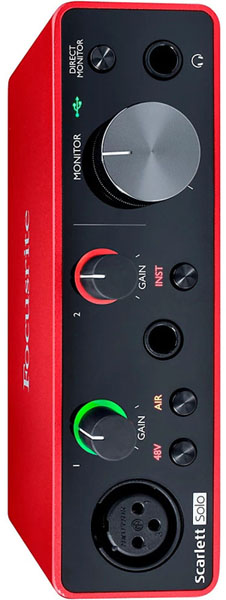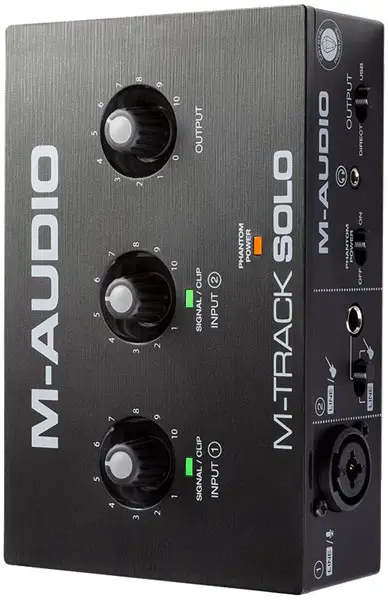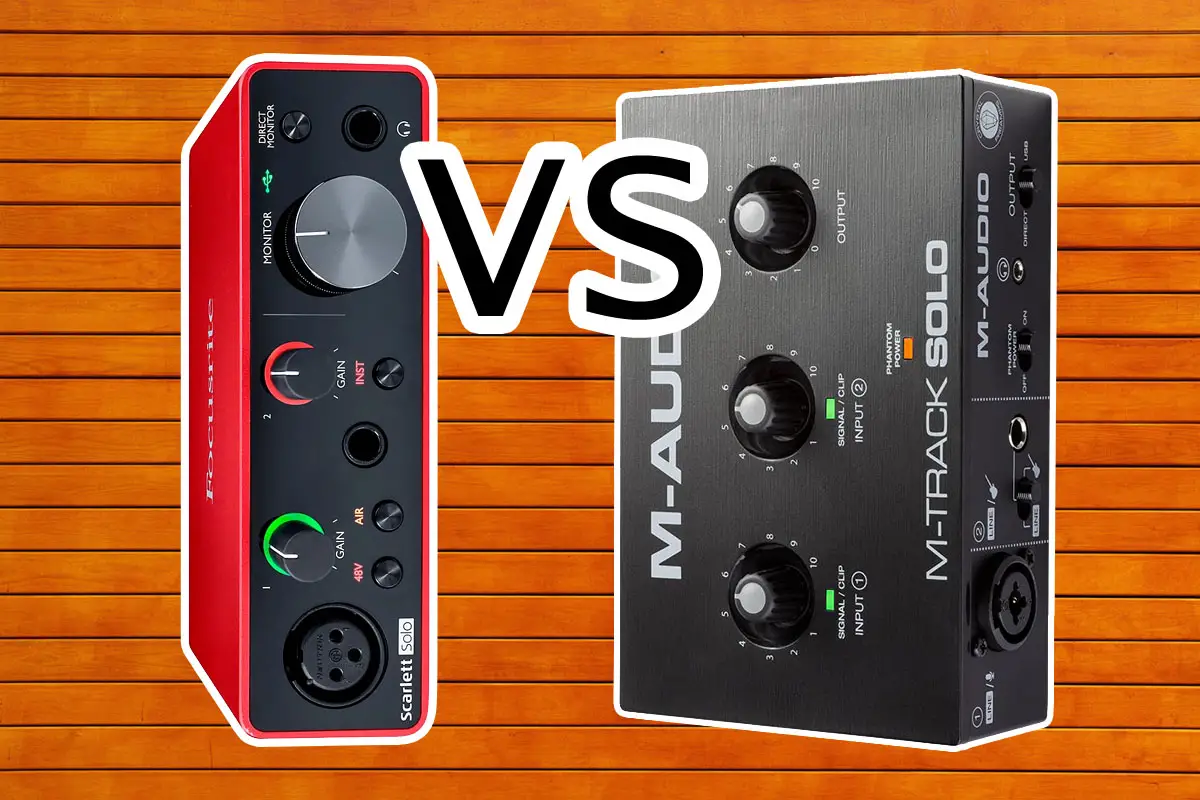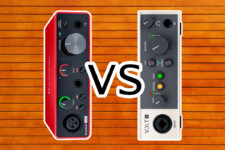Focusrite Scarlett Solo 3rd Gen vs M-Audio M-Track Solo: Which One Should You Choose?
If you are looking for a compact and affordable USB audio interface for your home recording studio, you might have come across two popular options: the Focusrite Scarlett Solo 3rd Gen and the M-Audio M-Track Solo.
Both of these devices are designed to provide high-quality sound and performance for singers, songwriters, podcasters, and other audio enthusiasts. But how do they compare and what are the main differences between them? In this article, we will help you understand the pros and cons of each interface and help you decide which one is best for your needs.

A Quick Look
If you are looking for a simple yet high quality interface that can add some warmth and brightness to your vocals and acoustic instruments, you might want to choose the Focusrite Scarlett Solo 3rd Gen. The Air mode can help you achieve a more airy and open sound that cuts through the mix better. The gain halo indicators can also help you set the optimal gain level for your recordings and avoid distortion or noise. It also has a higher sample rate and resolution than the M-Audio M-Track Solo, great for editing your recordings and keeping high quality sound.
If you are looking for a versatile and flexible interface that can connect different types of sources to the interface, you might want to choose the M-Audio M-Track Solo. The switchable instrument/line input can help you adjust the input impedance and gain to match your source and avoid clipping or noise. The Crystal preamps can also provide transparent and low-noise sound quality that can capture your sound source accurately and faithfully. A great budget option to get started started on your audio recording journey.

Focusrite Scarlett Solo 3rd Gen
- Mobile-ready, bus-powered, 2-in/2-out USB-C.
- Record at up to 24-bit/192kHz resolution.
- One XLR input with mic preamp, and one high headroom instrument input.
- Two balanced 1/4″ TRS main outputs.
- Switchable Air mode that gives recordings a brighter and more open sound.
- Unique halo level indicators that show you the input level and signal clipping.
- A direct monitor circuit that lets you monitor your input with low latency.
- 48V Phantom power switch for condenser microphones.

M-Audio M-Track Solo
- Mobile-ready, bus-powered, 2-in/2-out USB-C.
- Record at up to 16-bit/48kHz resolution.
- Zero-latency direct monitoring with a dedicated knob.
- One XLR mic input.
- One 1/4″ switchable instrument/line input that allows you to connect different types of sources to the interface.
- Crystal preamp provides transparent and low-noise sound quality.
- 48V Phantom power switch for a condenser microphone.
- Great value for money, excellent beginner option.
Common Features
- One mic input and one line/instrument input: Both interfaces have one XLR mic input and one 1/4″ line/instrument input on the front panel. This means you can record vocals and guitar or keyboard at the same time, or connect a microphone to capture any sound source.
- Phantom power: Both interfaces provide +48V phantom power to the mic input, which allows you to use condenser microphones that require external power. This is useful if you want to record vocals or acoustic instruments with a more detailed and accurate sound.
- Direct monitoring: Both interfaces have a direct monitoring feature that lets you hear your input signal without any latency or delay caused by your computer. This is helpful if you want to record with headphones and avoid hearing any echo or lag in your performance.
- Bundled software: Both interfaces come with a variety of software that can help you start recording right away. See the end of this article for a complete list.
Individual Features
Focusrite Scarlett Solo 3rd Gen
Air mode: The Focusrite Scarlett Solo 3rd Gen has a feature called Air mode that can be activated by pressing a button on the front panel. This feature emulates the sound of the original Focusrite ISA preamp, which adds brightness and clarity to vocals and acoustic instruments. This can help you achieve a more airy and open sound that cuts through the mix better.
Gain halo indicators: The Focusrite Scarlett Solo 3rd Gen has LED rings around the gain knobs that indicate the input level of your signal. The rings light up green when the signal is at a good level, red when the signal is clipping, and off when there is no signal. This can help you set the optimal gain level for your recordings and avoid distortion or noise.
24-bit/192 kHz resolution: Both interfaces support high-resolution audio recording and playback, which means you can capture every detail of your sound source and enjoy clear and crisp sound quality.
M-Audio M-Track Solo
Switchable instrument/line input: The M-Audio M-Track Solo has a feature called switchable instrument/line input that allows you to connect different types of sources to the interface. You can switch between instrument and line level signals by pressing a button on the front panel. This can help you adjust the input impedance and gain to match your source and avoid clipping or noise.
Crystal preamps: The M-Audio M-Track Solo has Crystal preamps that are designed to provide transparent and low-noise sound quality. The preamps have ultra-low distortion and high headroom, which means they can capture the natural tone and dynamics of your sound source without adding any coloration or artifacts.
Price Comparison
There is a significant difference in the price of these two interfaces, depending on where you buy them from. The Focusrite Scarlett Solo 3rd Gen costs around $120.00, while the M-Audio M-Track Solo is only $49.00.
This means that the M-Audio M-Track Solo is quite a lot cheaper than the Focusrite Scarlett Solo 3rd Gen, due to the lower recording resolution, and smaller list of included software.
Ultimately, the price is not the only factor to consider when choosing an audio interface. You should also think about your needs, preferences, and goals as a producer or content creator.
Sound Quality
The sound quality of an audio interface depends on several factors, such as the quality of the preamps, converters, drivers, and software. Both the Focusrite Scarlett Solo 3rd Gen and the M-Audio M-Track Solo have high-quality components that ensure clear and transparent sound quality. However, there may be some subtle differences in their sound character and tone, depending on your personal preference and taste.
The Focusrite Scarlett Solo 3rd Gen has a slightly warmer and smoother sound that can add some color and richness to your recordings. The Air mode can also enhance the high frequencies and add some sparkle and presence to your vocals and acoustic instruments. The M-Audio M-Track Solo may have a slightly cleaner and more neutral sound that can capture your sound source more accurately and faithfully.
Both interfaces have low noise and distortion levels, high dynamic range, and low latency performance. The Focusrite Scarlet has a higher dynamic range, however, the difference in sound quality between the two is subjective and depends on your needs and preferences. In general, higher bit depths are useful for editing audio because they reduce digital noise.
Compatibility
Both the Focusrite Scarlett Solo 3rd Gen and the M-Audio M-Track Solo are compatible with Windows and Mac computers, as well as iOS devices (with an adapter). They use USB protocol to connect to your computer or device, which means they are plug-and-play and do not require any external power supply. They also come with drivers and software that can help you set up and configure your interface easily.
Both interfaces are also compatible with most popular DAWs (digital audio workstations), such as Ableton Live, Pro Tools, Logic Pro X, Cubase, FL Studio, Reaper, GarageBand, etc.
Focusrite Scarlett Solo 3rd Gen Pros
- Air mode adds brightness and clarity to vocals and acoustic instruments.
- Gain halo indicators help set optimal gain level.
- Higher sample rate and resolution at 24-bit/192kHz.
- Metal case, and proven reliability.
Focusrite Scarlett Solo 3rd Gen Cons
- More expensive than M-Audio M-Track Solo.
- No MIDI in/out ports.
M-Audio M-Track Solo Pros
- Switchable instrument/line input allows you to connect different types of sources.
- Crystal preamps provide transparent and low-noise sound quality.
- Signal/Clipping LED indicators.
- Cheaper than Focusrite Scarlett Solo 3rd Gen, and with many similar features.
- Comes with more plugins from M-Audio and Avid.
M-Audio M-Track Solo Cons
- No Air mode or similar feature to enhance the sound.
- Lower sample rate and resolution at 16-bit/48kHz.
- Plastic case – more prone to damage.
- No MIDI in/out ports.
Which One Would You Choose?
Focusrite Scarlett Solo 3rd Gen vs M-Audio M-Track Solo: The Final Verdict
The Focusrite Scarlett Solo 3rd Gen and the M-Audio M-Track Solo are both excellent audio interfaces that can meet your home recording needs. They have similar features, but also some distinctive features that make them unique and different from each other. Ultimately, the choice between them depends on your personal preference, budget, and recording situation.
If you want a simple interface that can add some warmth and brightness to your vocals and acoustic instruments, go for the Focusrite Scarlett Solo 3rd Gen. If you want a cheaper, more versatile and flexible interface that can connect different types of sources to the interface, go for the M-Audio M-Track Solo.
If you are looking to remix and edit your audio recordings, then the Focusrite Scarlett Solo 3rd Gen would be the better option due to its higher sample rate and resolution.
Either way, you won’t regret choosing either of these interfaces, as they are both reliable, easy-to-use, and high-quality devices that can help you record amazing sound at home.

Bundled Software
Focusrite Scarlett Solo 3rd Gen
- Ableton Live Lite (a lite version of a popular DAW).
- Pro Tools First Focusrite Creative Pack (a lite version of another popular DAW with some plugins).
- Three months of Splice Sounds subscription (a platform that offers royalty-free samples, loops, and presets).
- Focusrite Red Plug-in Suite (a collection of EQ and compressor plugins).
- Softube Time and Tone Bundle (a collection of reverb, delay, distortion, and modulation plugins).
- XLN Audio Addictive Keys (a virtual piano plugin).
- Focusrite Plug-in Collective (a program that offers free plugins every few months).
M-Audio M-Track Solo
- Pro Tools First M-Audio Edition (a lite version of a popular DAW with over 20 plugins).
- MPC Beats (a software for creating beats and grooves).
- AIR Music Tech Xpand!2 (a virtual instrument plugin with over 2500 sounds).
- Eleven Lite (a guitar amp simulator plugin), Avid Effects Collection (a collection of 23 effects plugins).
- AIR Music Tech Creative FX Collection Plus (a collection of 20 effects plugins).
- AIR Music Tech Mini Grand (a virtual piano plugin), AIR Music Tech Strike (a virtual drum plugin).
- AIR Music Tech Hybrid 3 (a virtual synth plugin).
- AIR Music Tech Vacuum (a virtual analog synth plugin).
- AIR Music Tech BOOM (a virtual drum machine plugin).
- AIR Music Tech DB-33 (a virtual organ plugin).




